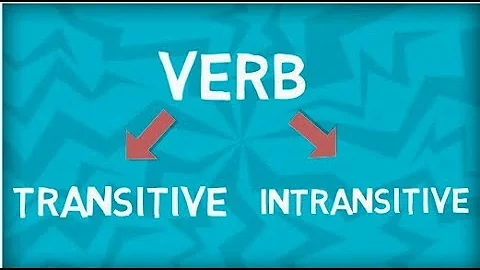Is this verb transitive or intransitive?
To decide whether the verb is being used transitively or intransitively, all you need to do is determine whether the verb has an object. Does she sing something? Does he leave something? The verb is only transitive when the answer is yes.
What are 10 examples of transitive?
Some other examples of transitive verbs are "address," "borrow," "bring," "discuss," "raise," "offer," "pay," "write," "promise," and "have."

What is transitive or intransitive verb examples?
A transitive verb is one that requires a direct object to finish its meaning. Example: He (subject) plays (transitive verb) guitar (direct object). An intransitive verb is one that does not need a direct object to complete its meaning. Example: She (subject) laughs and smiles (compound intransitive verb).
What are 5 examples of intransitive verbs?
Intransitive Verbs
- The cat purrs.
- The canary sings sweetly.
- The horse runs.
- The children laughed heartily.
- The steamer sails at noon.
How do I identify a transitive verb?
To decide whether the verb is being used transitively or intransitively, all you need to do is determine whether the verb has an object. Does she sing something? Does he leave something? The verb is only transitive when the answer is yes.
What are the 8 intransitive verbs?
An intransitive verb is a “verb that indicates a complete action without being accompanied by a direct object, as sit or lie, and, in English, that does not form a passive.” Our definition does a good job of saying what an intransitive verb is, but let's break the two major points a little more.
What are examples of transitive?
A transitive verb is a verb that uses a direct object, which shows who or what receives the action in a sentence. In the example “she gives a gift,” gives is a transitive verb and a gift is the direct object (what is being given).
What is this transitive verb?
What is a transitive verb? A transitive verb is a verb that uses a direct object, which shows who or what receives the action in a sentence. In the example “she gives a gift,” gives is a transitive verb and a gift is the direct object (what is being given).
How do you identify a transitive and intransitive verb by question?
Transitive verbs take a direct object—a word or word group that answers the questions what? or whom? after the verb. Intransitive verbs do not take an object.
How do you identify a transitive verb?
To decide whether the verb is being used transitively or intransitively, all you need to do is determine whether the verb has an object. Does she sing something? Does he leave something? The verb is only transitive when the answer is yes.
How do you know if its intransitive?
When there's an object in a sentence containing an action word, you're dealing with transitive verbs. If there is no object in a sentence containing an action word, yet the sentence still makes sense, then the action word is an intransitive verb.
How can you tell that a verb is transitive?
A transitive verb should be close to the direct object for a sentence to make sense. A verb is transitive when the action of the verb passes from the subject to the direct object. Intransitive verbs don't need an object to make sense – they have meaning on their own.
How do you know if a verb is transitive?
A transitive verb should be close to the direct object for a sentence to make sense. A verb is transitive when the action of the verb passes from the subject to the direct object. Intransitive verbs don't need an object to make sense – they have meaning on their own.
How do you test a transitive verb?
Transitive verbs take a direct object—a word or word group that answers the questions what? or whom? after the verb. Intransitive verbs do not take an object.
What is the rule for intransitive verbs?
As you might guess, an intransitive verb is one that does not need to transfer action on an object in order to make sense. Consider the verb to run. You can run without transferring the action of running on a direct object.
What makes a verb transitive?
A transitive verb is a verb that uses a direct object, which shows who or what receives the action in a sentence. In the example “she gives a gift,” gives is a transitive verb and a gift is the direct object (what is being given).
How do you identify intransitive and transitive exercises?
Transitive verbs are those verbs that have an object. Intransitive verbs are those verbs that do not have an object.
